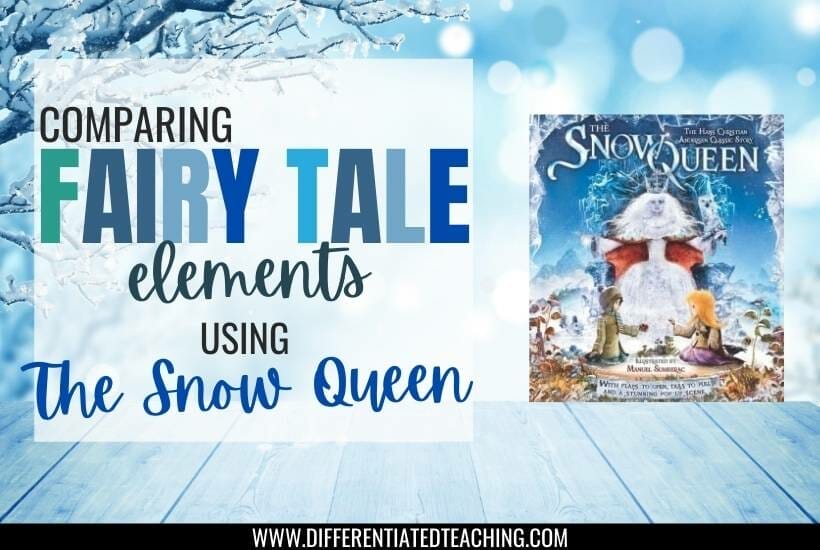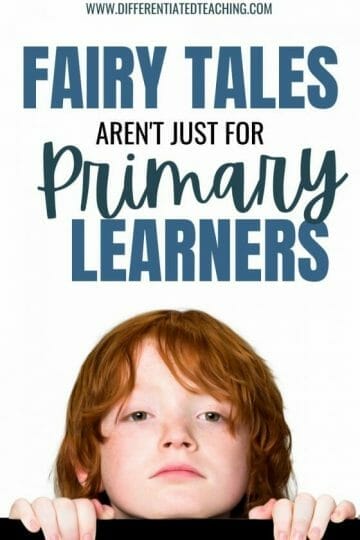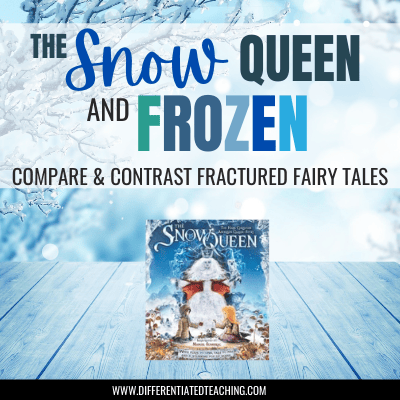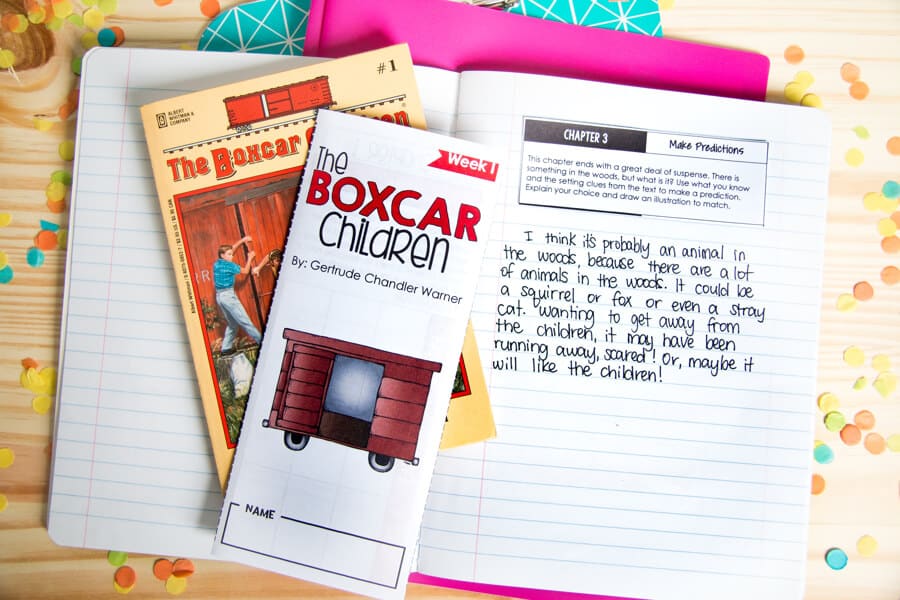The Snow Queen: Analyzing & Comparing Elements of Fractured Fairy Tales
Many kids are surprised to find out that Disney’s Frozen is based on The Snow Queen, a fairy tale from over 150 years old. Fairy tales offer a unique opportunity to teach students about the process of making connections between different versions of a story. With the plethora of fractured fairy tales available both in book and video formats, you’ll find that you’ve got ample resources to choose from when it comes to teaching students about this type of traditional literature. The bigger challenge might be finding a story that is new to your students.

In this post, I’ll share how you can use the popular Disney movie Frozen to introduce a fairy tale that most students haven’t heard before. The story is called The Snow Queen, and it is said to be the inspiration for Elsa & Anna’s story. However, as your students will soon discover, there are more than a few differences between the book and the movie.
Just want the free resources? Click here to access them now.
Fairy Tales aren’t just for little kids
Since a fairy tale is a narrative short story that plays on imagination, you might think they’re better suited for the primary grades. However, the reality is these stories were originally created for adults.

The earliest fairy tale was written in 170 AD by an anonymous storyteller. He told of a king and his wife who lived happily together until one day she fell ill. The king searched for a cure and found a fairy, who said that a pig’s heart would save the queen. The king, who was squeamish, was horrified and refused. Consequently, the queen died. The king was furious and imprisoned the fairy, and when she got free she swore she’d get revenge.
Why do I tell you all this?
Because fairy tales are a great tool to use when teaching older learners, who are better equipped to see beyond the basics and be able to more closely examine how historical context and who is telling the story play into the outcome.
However, to do so, they must first have a solid understanding of what makes a fairy tale.
Making the Connection with Fractured Fairy Tales
I’m not sure about you, but I’m pretty sure that I could recite the majority of Frozen in my sleep these days. My own kids love it and will happily listen to it on repeat.
That is when they aren’t watching Frozen 2…a favorite of my oldest who happens to be named Samantha.
So when you tell them you’re going to read the fairy tale that the story is based upon, get ready for the excitement to erupt. Of course, there are many different versions of The Snow Queen available so you’ll want to make sure you’ve picked the one most appropriate for your learners.
For third and fourth graders, I really like this version.
There’s also a great version of The Snow Queen that has beautiful watercolor illustrations online so don’t feel you need to have a physical copy of the book to implement the lesson.
Older students are better equipped to handle the complex language of the original, which was written in the 1800s by Hans Christian Andersen. This version is available as part of the public domain on Project Gutenburg.
What is the structure of a fairy tale?
Before you can really dig into the similarities and differences between Frozen and The Snow Queen, you’ll want to review the important elements of fairy tales.
Your students will likely recognize many of structures associated with fairy tales because they follow the pieces of other narrative texts they’ve read. The author begins by introducing the characters and setting. Then the story moves into the conflict, which is finally resolved as the story ends.

However, there are some unique characteristics of fairy tales that students need to know. Here are the big ones:
- Common opening & closing lines – Do the phrases “once upon a time” and “they lived happily ever after” ring a bell?
- A clear distinction between good and evil characters
- The inclusion of both magic and royalty – fairies, spells, witches, and princesses abound
- A problem that’s solution imparts a universal lesson
- Patterns or recurring numbers
Fairy Tale Elements in The Snow Queen
One of the first things you’ll want to do, if you’re planning to have students compare The Snow Queen to Frozen, is to break down the fairy tale elements in the text.

This can be done during the reading, which you can split across several days since there are a total of 7 parts. You can create an anchor chart to help your students track these throughout the book.
After the entire book is complete, it is important for students to review the details they recorded earlier so they’re ready to begin making comparisons after seeing the movie version.
When outlining the important elements, I like to use a flipbook format because it is approachable for students and only focuses on the most important pieces of information they need to know.
Keep reading to find out how to get a copy of this flipbook for free.
Finding the differences & similarities between Frozen and The Snow Queen
Once students are familiar with The Snow Queen, you can begin the process of comparing the story to Disney’s version. To help you prepare for the lesson, let’s break down the standards addressed, helpful graphic organizers, and explore the possible answers your students may come up with when comparing and contrasting these two stories.

Standards addressed:
- CCSS.ELA-Literacy.RL.4.7
- CCSS.ELA-Literacy.RL.5.7
- CCSS.ELA-Literacy.RL.6.7
- CCSS.ELA-Literacy.RL.7.7
A Venn diagram is a great tool for making these comparisons because it can be utilized at any level of the standard. For example, younger learners may only be examining the surface-level comparisons while middle schools examine how the techniques of the medium affect the reader/viewer.

Here are several key differences that should be discussed with students:
- The Snow Queen’s role in the story & how her powers impact others
- The protagonists understanding, control, and motivations to use her powers
- The cast of characters, overall – ages, genders, stature in the community, and role in keeping the plot going

For older students, you may also address how Disney softened the story and draw conclusions about the role historical context and audience play in the determination of the plot. Andersen’s story, for example, includes the morals that were common during the Golden Age of Denmark. You see the archetypical patterns of good vs. evil, the power of innocence, the separation of man from nature, and the stark contrast between summer and winter.

Of course, you’ll also want students to see the similarities between the two stories. For example, both stories center around a good main character that must be saved from the grips of a frozen heart. They also both share the theme that love can conquer all things and the dangers of isolation and fear.
Here are a few other good similarities to discuss with your students:
- The divide caused by the snow queen’s magic – although for Kai and Gerda this is a much larger physical separation.
- The Scandinavian setting
- The symbolism of the tears melting the cold
Grab the Lesson Materials
Enter your information to get the materials described in this lesson for free.
Other Mentor Text Lessons
Check out these additional mentor texts lessons comprehension lessons on my site:






